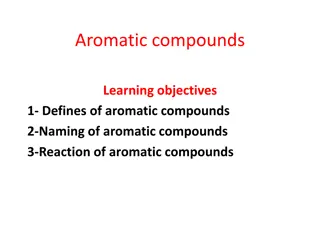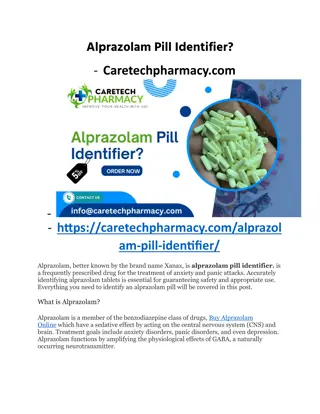Exploring the World of Esterification: Aromatic Fragrances to Pharmaceutical Applications
Esterification is a versatile chemical process that yields compounds with pleasant odors and diverse applications, from fragrances like banana and peppermint to pharmaceuticals like local anesthetics. The process involves reactions such as Fischer Esterification and Schotten-Baumann Esterification, resulting in the synthesis of various esters. Examples like aspirin synthesis and GHB production showcase the significance of esterification in creating important substances. Despite their beneficial uses, esters like GHB also pose risks when misused.
Download Presentation

Please find below an Image/Link to download the presentation.
The content on the website is provided AS IS for your information and personal use only. It may not be sold, licensed, or shared on other websites without obtaining consent from the author.If you encounter any issues during the download, it is possible that the publisher has removed the file from their server.
You are allowed to download the files provided on this website for personal or commercial use, subject to the condition that they are used lawfully. All files are the property of their respective owners.
The content on the website is provided AS IS for your information and personal use only. It may not be sold, licensed, or shared on other websites without obtaining consent from the author.
E N D
Presentation Transcript
Lecture 8a Esterification
Introduction Many esters have pleasant odors and some of them can even be found in nature. Compound Isoamyl acetate Ethyl butyrate Octyl acetate Methyl anthranilate Methyl butyrate Benzyl acetate Methyl salicylate Menthyl acetate Flavor/Fragrance Banana Oil Pineapple Orange Grape Apple Peach Oil of Wintergreen Peppermint Esters are often used in fragrances or flavoring agents due to their organoleptics properties. Some esters are used as sex pheromones i.e., isopropyl dodecenoates (attracts female beetles, used in alternative pest control) or alarm pheromones i.e., isoamyl acetate (honey bee)). Ester of p-aminobenzoic acid are used as local anesthetics with a short to moderate half-life (benzocaine (ethyl), procaine (2-(diethylamino)ethyl), propoxycaine, etc.).
Theory I Esters can be obtained by a broad variety of reactions Fischer Esterification (used in Chem 30BL) O C H+ RCO2H + R'OH + H2O R OR' This approach works well for primary and most secondary alcohols, but not for tertiary alcohols because of their high tendency to eliminate water instead of forming an ester. Acyl chloride Works for tertiary alcohols as well because of non-acidic conditions. Accessibility of SOCl2 Anhydride Accessibility of anhydrides Often also requires an acidic catalyst i.e., aspirin synthesis. acid alcohol ester O O O SOCl2 OH Cl ROH/Pyridine -PyH+Cl- OR -HCl, SO2 Schotten-Baumann Esterification O O O ROH/H+ ROH/H+ OR OH OR OR O -H2O O O O
Theory II Example 1: Aspirin (Bayer AG,1899) It uses salicylic acid, acetic acid anhydride and a mineral acid as catalyst (usually conc. phosphoric acid). The phenol group acts as the alcohol in the reaction. Methyl salicylate Topical analgesic The serin group the cyclooxygenase is blocked , which causes a suppression of the prostaglandin synthesis Aspirin is considered a pro-drug for salicylic acid, which was long known (Hippocrates, bitter willow bark extract, 5thcentury BC) to work against inflammations and fever but it caused vomiting and nausea. The reaction of salicylic acid with methanol in the presence of a mineral leads to the formation of methyl salicylate (Oil of wintergreen), which is used as topical analgesic.
Theory III Intramolecular esterification afford lactones (i.e., coumarins). These reactions can usually be carried out under mild conditions. Example 2: GHB ( -hydroxybutyric acid) O H+ HO COOH O Lacton mild conditions GHB GBL It is used as date rape drug: Liquid Ecstasy. It is colorless, odorless and has a slightly salty taste. It is very dangerous because the effect of the drug differs greatly. More than 200 deaths and more than 5700 overdoses have been attributed to this drug since 1990. The major problem is that humans can have very different reactions to this drug particular in connection with the consumption of alcohol.
Theory IV Example 3: Biodiesel It has gained a lot of interest lately due to the ever increasing cost of gasoline over the past decades. It uses renewable resources i.e., plant oils, algae, grease, etc. O O O R2 R1 O OH R1 O O NaOH O + 3 CH3OH + R2 O O O OH OH R3 O R3 O Methanol Triglyceride Methyl esters of fatty acids Glycerin Trans-esterification: It converts oils into methyl esters that are much more volatile than oils due to their lower molecular weight. It is important that water is absent during the reaction to avoid the formation of soap (Na+ RCOO-, where R= C17H35, etc.). Food vs. Fuel debate (i.e., 80 gal/acre for soy and sunflower): 42 billion gallons of diesel in 2008 in the US: 525,000,000 acre (21.6 % of the US). If the gasoline is also included (135 billion gallons) about 70 % of the area is needed. In 2013, industry produced 1.8 billion gallons of biodiesel.
Theory V In the lab, an unknown carboxylic acid is reacted with an unknown alcohol (both assigned by the TA). O C H+ RCO2H + R'OH + H2O R OR' acid alcohol ester Problems: The reaction is an equilibrium reaction with poor yields if a 1:1-ratio of the reactants is used. The carboxylic acid is a poor electrophile (neutral). The alcohol is a poor nucleophile (neutral). The reaction is very slow at room temperature. Any water in the reaction mixture lowers the yield significantly.
Theory VI Mechanism of Fischer Esterification O C OH OH C OH OH C OH O R R R H + H+ R' OH R' O C OH + OH C OH H+ R R OH C OH O R' activated carbonyl (no charge separation) better electrophile R (charge separation) + H+ H2O is a good leaving group + OH C O H+ O C OR' OH C OR' H H2O R R R H OR' In the neutral state, the resonance structure with the charge separation is a very minor contributor making the carbonyl function of the carboxylic acid a poor electrophile. The situation changes in the protonated form of the carboxylic acid in which the carbonyl carbon bears a larger positive charge (~0.2 units in the case of acetic acid), which makes it a better electrophile.
Theory VII Le Ch telier Principle If equimolar amounts of the carboxylic acid and the alcohol were used, the theoretical yield would be low i.e., 67 % (Keq=4). O C R OR' H2O Keq = 1 10 RCO2H R'OH One or all products have to be removed from equilibrium, which will not work here because water and the esters have higher boiling points than the alcohols. Thus, an excess of one the reactants has to be used. The carboxylic acids cannot be used in excess because all of them are solids. The reaction in the lab uses an excess of the alcohol: The alcohol doubles up as the solvent and as a reactant in the reaction. Usually about 4-10 fold molar excess in the literature (a five-fold molar excess is used in the Chem 30BL lab i.e., 10 mmol of the carboxylic acid are reacted with 50 mmol of the alcohol).
Theory VIII A strong mineral acid is usually used as catalyst: The carboxylic acid is neutral and a weak electrophile. The mineral acid protonates the carbonyl carbon atom and increases its electrophilic character. It is very important to reflux the mixture properly to increase the rate of the reaction i.e., for every 10 oC temperature increase, the rate of the reaction about doubles (Arrhenius equation). A rate = Ea * e RT
Theory IX Which compounds are present in the reaction mixture after the reaction is completed? Ester, alcohol (used in excess), carboxylic acid (should be a small amount), sulfuric acid (used as the catalyst). All of the alcohols (log Kow= -0.77 (MeOH), -0.24 (EtOH), 0.05 (iso-PrOH), 0.25 (PrOH)) and the sulfuric acid (log Kow= -2.20) are soluble in water. The carboxylic acid and the sulfuric acid can be extracted with a weak base i.e., NaHCO3 while the ester and traces of the alcohol remain in the organic layer. They are separated by a fractionated vacuum distillation later. Sodium hydroxide cannot be used for the extraction step because it would destroy the ester (saponification) due to its higher nucleophilicity. Water Extraction: RCO2R' RCO2H H2SO4 RCO2H R'OH RCO2R' organic phase 1. mix H2SO4 RCO2H ROH H2SO4 aqueous phase t = 0 t >> 0 (water just added) NaHCO3 Extraction: R'OH RCO2H R'OH RCO2R' RCO2R' organic phase 1. mix R'OH H2SO4 Na+RCO2 Na+HSO4- aqueous phase (5% NaHCO3) t = 0 t >> 0 (5% NaHCO3 just added) O O + OH- + R'OH O- R R OR' base-catalyzed ester hydrolysis e.g. conversion of fats to soap
Experiment I Dissolve the unknown carboxylic acid in the alcohol in a 10 mL round-bottomed flask (both assigned by your TA) How much of the acid is used for the reaction? How much alcohol should be used here? Why is a 10 mL round- bottomed flask used here? How much is appropriate here? What does this imply in terms of equipment and setup? 1. Air condenser with wet paper towel 2. Stir bar 3. Drying tube with CaCl2 1.0 g 5 mol equivalents Add a few drops of concentrated sulfuric acid Reflux the mixture for at least 60 minutes (the longer the better) 3-4 drops
Experiment II Cool the reaction mixture down How can this be accomplished quickly? Which container should be used here? Why is the water added? To cause a phase separation Ice-bath Add ice-cold water to the reaction mixture Centrifuge tube How much water should be added? Usually 4-8 mL What should the student observe/not observe here? The formation of a solid indicates a poor conversion of the acid Which one is the organic layer here? Usually the bottom layer=ester Remove the organic layer
Experiment III Extract the aqueous layer with diethyl ether Why is the aqueous layer extracted with ether? To collect the suspended and dissolved ester How much ether should be used here? Which layers does this referred to? Why is this step performed? How much solution is used here? How many extractions should be performed? Until the CO2 formation ceases 2 x 3 mL Combine all organic layers Ester + two ether layers Extract the combined organic layers with sodium bicarbonate solution 1-2 mL portions
Experiment IV Dry the organic layer over anhydrous sodium sulfate Remove the ether and remaining alcohol using the rotary evaporator Perform vacuum distillation How much drying should be used? A small amount to start with! Why is a vacuum distillation performed here? Vapor Pressure of Methyl Benzoate Vapor Pressure (in mmHg) 200, 760 175, 400 151, 200 100 131, 100 117, 60 108, 40 92, 20 10 77, 10 64, 5 1 39, 1 20 70 120 170 Note that the drying tube does not contain cotton or CaCl2! Boiling Point (oC) What is the setup for the vacuum distillation? What should the student do if he had a liquid in the Hickman head and also in the flask/vial? Acquire an infrared spectrum for both liquids and only submit the ester for NMR analysis Collect product from Hickman head Acquire an infrared spectrum and the refractive index of the ester. Submit the rest of the sample, even if it is solid or semi-solid) for NMR analysis (label vial and sign in the sample as well)
Characterization I Infrared Spectrum Benzoic acid (C=O)=1689 cm-1 (OH)=2300-3300 cm-1 (C-OH)=1030 cm-1 Methanol (OH)=3347 cm-1 (C-OH)=1030 cm-1 (OH) (C=O) (C-OH) (OH) (C-OH) Methyl benzoate (C=O)=1724 cm-1 (COC)=1112, 1279 cm-1 No OH peaks in the ester (C=O) (COC)
Characterization II Refractometry The refractive index is a physical property specific to a compound Light is refracted when passing through any medium (Snell s Law) In the lab, it is used to determine identity and purity of a sample using an Abb refractometer light angle theta condensed medium surface angle phi Adjust the height of the dark field so that the edge intersects with the crosshair before adding sample to refractometer after adding sample to refractometer (ideal) after adding sample to refractometer (non ideal) The refractive index is wavelength and temperature dependent ( =589 nm, T=recording temperature) nX D = nT D + (T-X)*0.00045 a a
Characterization III 1H-NMR Spectrum for Methyl benzoate 9.5 O d, 2 H ortho 9.0 5.5 CH3 8.5 O 5.0 8.0 s, 3 H OCH3 7.5 4.5 t, 2 H meta 7.0 6.5 4.0 t, 1 H para 6.0 3.5 5.5 5.0 3.0 4.5 4.0 2.5 3.5 2.0 3.0 2.5 1.5 2.0 1.0 1.5 1.0 0.5 0.5 0.0 0.0 8.0 7.5 7.0 6.5 6.0 5.5 5.0 4.5 4.0 3.5 3.0 2.5 2.0 1.5 1.0 0.5 8.40 8.30 8.20 8.10 8.00 7.90 7.80 7.70 7.60 7.50 7.40 7.30 7.20 7.10 7.00
Characterization IV 13C{1H}-NMR Spectrum for Methyl benzoate 120 120 O 9 O 10 115 115 110 110 6 7 128.40(5;3) 129.70(2;6) 128.45(5;3) 130.19(2;6) 105 105 CH3 9 6 7 OH 8 5 1 100 100 O 8 5 1 95 95 90 90 4 2 4 2 85 85 3 3 80 80 75 75 70 70 65 65 60 60 55 55 132.80(4) 51.00(9) 133.76(4) 50 50 45 45 40 40 35 35 30 30 25 25 CDCl3 CDCl3 20 20 170.39(7) 130.02(1) 166.80(7) 15 15 76.28(Sol.) 77.08(Sol.) 77.88(Sol.) 76.28(Sol.) 77.08(Sol.) 77.88(Sol.) 10 10 5 5 0 0 180 170 160 150 140 130 120 110 100 90 80 70 170 160 150 140 130 120 110 100 90 80 70 60 50 40
Characterization V What is that? 120 115 17 110 16 128.00 128.45 129.50 130.19 105 65.90 15.20 15 100 95 14 90 13 85 12 80 75 11 70 10 65 9 60 132.40 133.76 60.80 14.40 18.14 55 8 50 7 76.28 77.08 77.88 45 6 40 35 5 30 4 25 3 20 170.39 166.30 15 2 10 1 5 0 0 8.5 8.0 7.5 7.0 6.5 6.0 5.5 5.0 4.5 4.0 3.5 3.0 2.5 2.0 1.5 1.0 0.5 0.0 150 100 50 0
General Hints The reaction should be started as soon as possible in order to have a long enough reaction time. Dry glassware is very important here. The reaction mixture has to be properly refluxed. The air condenser has to be properly cooled with a wet paper towel, which has to have an intimate contact with the air condenser (no Hickman head here!!). The purer the final product is, the easier the analysis of the NMR spectra will be. The student should submit something even if it is a solid that just had a pleasant odor to it. It is advisable to acquire a refractive index of the alcohol. Do not obtain the melting point for the carboxylic acid.























